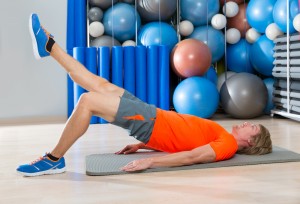Warming up…do you stretch or don’t you? Is it safe to stretch or could it cause injury?
It is very difficult to prove whether stretching prevents injury because there are so many contributing factors; it is impossible to replicate the same experiments in the same participants; and it is unethical to try to deliberately injure participants in a study. Also, we must consider the different contributions to joint mobility caused by muscle flexibility as opposed to other causes (e.g. bony alignment).
However, whatever you ‘do’ before your training session with clients, it is all for similar reasons:
– Prevent injury
– Improve performance
– Get mentally ready to train
Why Warm Up?
A warm-up should be a vital part of all training sessions, especially resistance training. Improving performance is a reason for doing a warm-up that the majority of people overlook. Done correctly a warm-up should activate, mobilise and potentiate the body. This ultimately will increase flexibility, range of movement and switch on muscles ready for training.
Obviously a lot of people will give the excuse of having little or no time to train, never mind ‘wasting’ this on a warm-up. Ideally a warm-up should take no longer than 10 to 15 minutes to complete. A correctly performed warm-up will be an asset to your training, not a hindrance.
A warm-up should contain exercises which increase the raise heart rate, then activate specific muscle. Look to increase mobility and then potentiate the muscles ready for the stress the body is about to undertake. Here is more detail of each of the 4 sections of a ‘RAMP’ warm-up:
The RAMP Warm Up
Raise – simply raising heart rate and therefore blood flow around the body. A jog, star jump, skip, row or any other low intensity whole body activity is usually perfect for a ‘raise’. Spend no longer than 2 minutes doing this, you can mix and match the activity depending on what equipment or space is available. For sprinters or other games based athletes, ask yourself the question is it suitable to just jog or row…try and make each part of your training as specific as possible, if you can do a skip this may be more specific to your needs.
Activate – this is ‘switching-on’ your muscles, your everyday activity may not use the muscles you are going to train so you will need to activate them. Examples of great exercises for this are: Glute-bridge, lunge, squat, plank, TYW’s and MANY more. If you are unsure of any of these exercises, I would advise typing them into YouTube. Aim to target each of the major muscle groups, so 4 to 5 different exercises will suffice.
Mobilise – doing mobility before your training is a fantastic way to increase flexibility and range of movement during your key lifts. Again if you are unsure on any exercises then just use the internet. T spine rotations, Spiderman’s, leg throughs, hamstring walkouts, downward dogs, cobras and cat-camels are all great ways to mobilise the body.
Potentiate – a scientific way to incorporate jumping into the warm-up. Jumping from two legs and landing on two legs is a simple but good exercise, variations of this include single leg alternatives. Again, for sports athletes this is a great way to get some plyometric exercises into the session. Remember for plyometrics the best prescription is little and often so the end of a warm-up is perfect.
So there you have it, the RAMP warm up and some ideas of exercises you can do for each section. Give your warm up the same amount of attention as you would do the rest of your client’s workout. Do not neglect it!



Leave a Reply